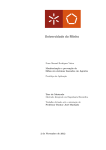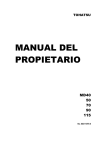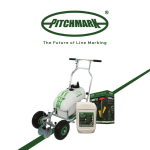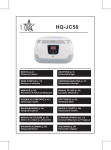Download McCulloch Foliage 5-500W Specifications
Transcript
WWW.HEDGE‐ TRIMMERS.CO.UK Scott Morris EVERYTHING YOU WANT TO KNOW ABOUT HEDGE TRIMMERS Contents The History of the Hedge Trimmer ......................................................................................................... 2 How to Choose a Hedge Trimmer ........................................................................................................... 5 Cordless Hedge Trimmers ....................................................................................................................... 8 Choosing a Mains or Petrol Powered Hedge Trimmer ......................................................................... 10 Care and Maintenance of your Hedge Trimmer ................................................................................... 12 Features & Functions of Hedge Trimmers ............................................................................................ 14 Hedge Trimming Tips ............................................................................................................................ 16 Essential Safety Tips for Hedge Trimmers ............................................................................................ 19 1 The History of the Hedge Trimmer Hedge trimmers have been needed for as long as hedges were first used to delineate fields and to protect crops and animals from excessive sun, wind, driving rain or snow. Hand shears were the weapon employed for centuries, but in the innovative 19th century there were many attempts to invent labour-saving devices for use out in the fields, and some of these are enshrined in patents. Then in the 20th century, the populace started to acquire gardens and a whole new requirement arose. The timeline of key years in hedge trimmer development is shown below. 1854 Leonard Wood of Idaho proposes a device whose travelling wheels carry it alongside the hedge but also drive gearing that activates the ‘nearly vertical’ cutter wheel and the horizontal cutters. Like all devices of its period this relies upon horse-drawn propulsion, or later, steam power, but hand-held devices are a long way off. 1865 A. Selover patents a wooden construction which still relies upon a saw but has adjustable clamps and screw rods to control the height and width of the cut. 1871 James and Oliver Vannosdall patent another framework device. 1890 Andrew Fox of Dayton Ohio invents a machine with a base unit with an inverted V hood shape and a series of cutters at the front edge. This is beginning to get closer to the idea of multiple blades that we see today. 1891 Robust Elliot patents what he calls a ‘portable’ device but it is a truly scary-sounding unit of torture which requires the poor operator to be fastened to an endless traveling cable, supported at either end of a field and ‘kept in motion by any suitable power’. This demonstrates that it would take the invention of small lightweight motors and frames for there to be a modern hand-held device. 1922 The Little Wonder company of the UK launch a hand-cranked hedge trimmer. This is the first of the modern-day hand-held reciprocating-blade devices as we know them. It stays in production right through to the 1950s and becomes a rapid hit not just with horticulturalists but with pasta makers! The razor-sharp blades prove to be ideal for delicately slicing the hand-made strands. In 1935 the company was bought out by Schiller of the USA and moved there: they still manufacture in 3 US plants. 1940 Little Wonder launch the first single-blade reciprocating electric hand hedge cutter. 1945 They add the first double-blade reciprocating cutter. 1955 They bring out the first-ever petrol-engined model. Baby Boom Thereafter, the post-war development of these machines is reminiscent of that of chain saws: the same manufacturers began to bring out smaller, lighter trimmers based on the new alloys 2 and using 2-stroke motors for the petrol models. There was a greater emphasis on electric motors from the start, in volume sales terms these being essentially garden devices rather than remote outdoor machines like chainsaws. One very notable brand in hedge trimmer history is Black & Decker, which was a leader in popularizing this new electronic gadget with homeowners. As early as 1962 they brought out a version with a self-contained battery power pack. However it would take further developments in battery technology before truly satisfactory performance could be achieved. In the modern market, the cordless sector is firmly established, with B&D and other brands including Bosch, Makita, Einhell and Ryobi offering a range of sizes and power levels. Black & Decker’s pre-eminence in electric drills led them in the 1970s to bring out attachments which included a hedge trimmer unit, but it was not as versatile as a bespoke machine. McCulloch, one of the chainsaw pioneers, diversified into hedge trimming in the 70s. Nowadays they are owned by Husqvarna, the world’s largest producer of outdoor power products, and you can buy their various models under the names of Husqvarna, McCulloch, Gardena and others. McCulloch continue to innovate in the petrol sector, with a fuel pump for easy starting and very lightweight 5kg petrol machines. (Most are 6, 7 or more kg). Leading gardening brand Gardena is the name for the cordless range, including long reach models. An important new feature was invented by Echo, who created the first long-reach trimmer that articulated to allow users to shape hedges in high and awkward places. Today, many top-end models have pivoting handles that bend to allow different angles to be more easily achieved when cutting. The shape of things to come Innovation never ceases: as recently as May 2011 a US Patent was granted to Techtronic Outdoor Products Technology for a Multipurpose Debris Deflector. Most machines can sometimes throw the waste at you or in all directions so this, and similar devices that are beginning to appear, are welcome. Such safety improvements are an important factor: for example it is now mandatory that both hands have to be on the handles before the device can function. New cut-off devices have appeared as a result. Development in the petrol engine field has been spurred on by Governments, notably in the USA. Two-stroke motors are light, do not require an oil tank, and have the advantage of being able to operate at all angles including upside down. Their own downside is their poorer emissions record when compared to a 4-stroke as used in cars. Ryobi have brought out a ‘No Mix 4 cycle’ motor that meets the toughest (Californian) regulations. It claims to work in all positions as well. Initially applied to string trimmers (‘strimmers’), it will surely transfer to hedge trimmers. 3 Within the 2-stroke engine market, improvements are also being made. Back in 1998 Tanaka claimed their new motors were 70% lower in emissions than previously. Briggs & Stratton and other established makers are gradually working to lessen their carbon footprint and to meet the much tighter State air pollution restrictions. Outside the scope of this article, there is the continuing use of hedge trimming devices that attach to tractors, and in the commercial farming and parkland sector these take care of the vast majority of hedges. Wherever they are in use, the hedge trimmers will continue to shape our landscape and it is hard to see them going away in our lifetimes. 4 How to Choose a Hedge Trimmer Back in the 1970s, your choice of hedge trimmer was pretty simple. If you were a home user and you wanted to keep control of your privet hedge, you bought a Black & Decker electric trimmer with a long lead. On the other hand if you were a professional groundsman doing heavier work and often operating in a park well away from any shore power, you selected one of the early 2-stroke petrol-engined machines from the likes of McCulloch. Nowadays, your choice is far greater. How do you determine which type of machine to buy, and what are the differences between brands? In terms of types, you have three choices. Cordless Hedge Trimmers This is the newest segment of the market and probably the fastest-growing. The revolution in battery technology, spurred on by automotive research, has brought us new types like Nickel Cadmium and especially Lithium Ion, which have lower weight, quicker charging, longer life and greater power than ever before, so that a whole new range of machines can now be effectively powered by these means. Most cordless trimmer motors run on 18 volt batteries, but at the top end brands like Bosch and Makita offer really powerful 36V models. The cordless trimmers offer a range of usable time from 30 to 55 minutes. Charging typically takes 3 hours but some models using the latest fast chargers and Li-ion batteries are achieving sub-1 hour times: a premium Bosch model claims just 45 minutes. Although battery hedge trimmers are generally used for light duties, some do offer wider cutter gaps (of some 15mm rather than 10mm) which are normally more associated with powerful machines. In association with a strong motor, this allows mature hedges and shrubs with medium diameter stalks to be cut without jamming the machine. The specialist short-cutter shrub cutting trimmers / garden shears are generally cordless devices and battery power is perfect for this application. Corded (Electric Hedge Trimmers) Machines with cables attached obviously have an Achilles heel when compared with their battery brothers, but if the work that you intend to do is likely to be within reach of a heavyduty cable extension then you may elect for the traditional mains-powered hedge trimmer. With 240 volts and much greater torque, these trimmers can cope with rougher treatment. They are also lighter to hold, not having to carry a battery: an average sub-18” cutter-length machine is between 2 and 3 kg compared to 4 kg or more for an equivalent cordless. 5 This allows greater tooth spacing – from 16mm on smaller machines to as great as 34mm on the biggest Bosch machines, which permits small trees to be pruned. Hand in hand with this is the greater cutter bar length that can be offered: there is a range of sizes right up to 750mm / 29.5”. Check the length of cord supplied with a machine – many have 10 metres but some supply 12 metres. If using an extension, make sure it is a 13 amp one with a thermal cutout. And always purchase an RCD breaker to protect yourself against any accidental cable cutting. Petrol Hedge Trimmers Petrol power (or gas power for US readers) is still popular because it offers the same goanywhere capability as cordless electric, plus the ability to keep on working so long as you have brought along a relatively small amount of spare 2-stroke mix (of petrol and oil). All the same features are on offer from manufacturers as in the electric sector of the market. The potential downsides are the pollution of the engine (despite recent improvements from most manufacturers) and sometimes, the difficulty of starting the engine with the pull-cord. Extremes of temperature, rain or snow, and high altitude can all adversely affect the willingness of the engine to start. This makes the models that offer easy starting attractive. This includes those from Hitachi with its ‘S-Start’ or McCulloch who offer a fuel pump that reduces the starting effort. Petrol machines with their self-contained power plant and tank are a bit heavier than any other kind, ranging from a lightweight McCullough model at 5.1kg to up to 7kg in some models. One aspect to remember is that petrol-engined machines are noisy: they can be over 100dB beside the machine and operators must wear ear defenders. Those with nearby neighbours should also think about the noise nuisance factor. Whereas most big-selling electric models are typically 400W in power, rising to around 700W for the most powerful Makita, petrol machines are all relatively powerful: the excellent 21.1cc Hitachi engine has 740W. And petrol machines top the size league, with bar lengths of up to 31”/780mm in the case of an extra-long Hitachi 23.9cc/ 810W model. When buying a machine, look at the fuel tank size: the domestic-use McCullough model has 0.2 litres but professional units have 0.6 litre tanks that allow long uninterrupted periods of use. On all types of trimmer, a very useful feature is a swivelling rear handle that allows vertical or angled trimming to be carried out much more easily and accurately. There are various types of arrangement: Draper hedge trimmers have a patented 5-position rotating handle. Long-reach models can be bought in electric or petrol types: they are specialist machines but very useful for tall or awkward hedges and shrubs. 6 So in the modern market there is something for everyone: some makers like Bosch, who offer home user and professional models, seem to cover every little niche. Get professional advice and you will find a machine that suits you and your hedge right down to the ground. Types of blades Hedge trimmer blades range greatly in length, and again the one which is suitable for you will be dependant upon the work you will be carrying out. The smallest blade is six inches and is usually used for detail work on small hedges or topiaries. It is advised that in the normal family setting a gardener would not need a blade larger than eighteen inches. At the other end of the scale you have the 28 inch blade. These are obviously used in tandem with the heavier trimmer (and by default the petrol trimmer) and are largely found in commercial settings. You should be aware that the longer the blade the heavier it will be and so the harder it will be to control. If you are considering working with the larger blades (and trimmers) ensure you feel safe with it before use. 7 Cordless Hedge Trimmers This most recent of the Hedge Trimmer types has also seen probably the most development work on the part of manufacturers, and the greatest improvement in machine capabilities. At the heart of this innovation lie the new types of battery that are available. The types used now are either Nickel Cadmium (NiCd) or Lithium Ion (Li-ion). Former problems of ‘memory effect’ that used to shorten effective battery charge life have been banished. They are lighter, more powerful, charge quicker and last longer. Generally speaking NiCd is used in cheaper models and the more expensive and powerful Liion batteries are deployed in higher-specification machines: but this is not an infallible guide to performance. The small Bosch 16” has a 14.4V (NiCd) power rating rather than the 18V normally found on others but it boasts the longest running time of its class at 55 minutes (others manage less than 30 minutes). A feature worth looking for when choosing a cordless hedge trimmer is a pivoting head or rotating handle, which allows you to cut precise angles or vertical faces easily. This sort of function is built in to the Black & Decker hedge trimmer 20” model and the Gardena 19” Ergo Cut. Because batteries are expensive and more and more cordless tools are appearing, it is high time that there was some standardisation in the power packs and their charging apparatus. Two manufacturers that have grasped this nettle are Ryobi and Bosch, who offer units that will power not one but many compatible machines of different functions, such as drills and chain saws. Ryobi call their initiative the ONE + concept. Their latest charger will work on either type of battery. Check, by the way, that your chosen machine does include a battery: if you do not read the advertisement closely you may find that the surprisingly good headline price for a smart machine may in fact be because it is battery-free. Weight may be an issue for some users who do not pump iron and would rather avoid repetitive strain injury. The latest designs from Bosch have aimed for weight reduction and have gone down by 30%: they are achieving as low as 2.2kg, whereas others weigh in at more than 4kg in the same sub-18” category. Other nice-to-have features in your trimmer are good ergonomic design that incorporates soft-grip handles: low vibration (such as Black & Decker offer with their asymmetric blade design) and it is worth checking that the blades are laser-cut and diamond ground for maximum effectiveness. Be aware that after your cutting session of (usually) 30 to 50 minutes, you are in for a lengthy charging period. You can of course avoid this problem by acquiring another battery and charging it offline. However you should also see how long your planned machine requires for a recharge. Most manufacturers quote 3 hours for their 18V units. One notable exception is Bosch, which offers two different novel solutions. 8 Their 20.5” machine carries a twin pack of 14.4V (1.5 amp-hour) batteries. By this means it achieves a running time of 70 minutes (2 x 35 minutes per battery) and a recharging is made easier using standard Bosch units charged offline while you work. Cleverer still is the 21” premium model that has a 36V Li-ion battery, a 50 minute run time and charges itself in just 45 minutes: if you are really in a hurry it will be 80% recharged in 25 minutes. Barely enough for a coffee break. This same Bosch hedge trimmer model adds features like 20mm blade spacing and a sawing function at its tip which means that branches of up to 25mm diameter can be despatched, something that previously was unthinkable from a cordless hedge trimmer. An electronic anti-blocking feature protects the machine from damage. There is also an extra protector for safe cutting along edges of walls or near the ground. Right at the top end of the cordless market, in terms of size, specification and price, is the professional 21.5” Makita. This achieves the same 36V as the Bosch by packing two 18V Liion batteries. It claims a lower than usual noise level of 86.5dB (these are not quiet machines even in electric form due to their high-speed reciprocating blade mechanisms). It also carries features that include a battery protection circuit, and protection from over-discharge, high temperature and overloading. These are very wise precautions because Li-ion batteries are more prone to damage as a result of such abuses. Most machines sold in this market are the smaller ones with blade lengths of under 20 inches. In this mainstream sector it is worth mentioning the models from German garden equipment specialist Gardena. In addition to their typically well-designed and constructed Easy Cut 19.5”, which has a large starting button for easy operation, they have an Ergo Cut version with relatively wide blade spacing of 16mm to deal with thicker growth than you can normally tackle. (Most competing models are for light duties and have tooth spacings of 10mm to 12mm). The same model has a blade protector. For most users in the hedge trimmer market, there is a cordless hedge trimmer model that will suit: and when you add into the equation the extra safety of not trailing a live cable near a cutting device, and it makes the cordless route a very attractive one. 9 Choosing a Mains or Petrol Powered Hedge Trimmer Given that cordless hedge trimmers have taken a large chunk of market share at the lightweight domestic end of the market, there is still a good slice of the hedge trimmer scene that is fought over by mains electric machines and ones with their own petrol (or Gas for American readers) power packs. Here we try to pick out some key features and benefits that might help direct your choice. Corded Mains Trimmers We can usefully classify these machines by the length of their blade bars as this gives a good indication of how big the intended work is. In the under-18 inch category there are some machines that are especially light, which may appeal to many: Black & Decker’s 16.5” trimmer weighs in at only 2.2kg, whereas most in this sector are around 3 kg. Expect power output of about 400W: the highest in this sector is the Makita 17.5” that has 550W. It also boasts a 0.05 second reaction from its mechanical brake, a reassuring feature to have on safety grounds. Most of the short trimmers like this have a 16mm gap between blades: the wider the gap the larger the branches that can be cut, but manufacturers can only offer the wider spacings where the motors can cope with the extra load. If you want to handle slightly more than the light type of trimming, opt for a bigger machine: this after all is why you are choosing a mains electric device over a cordless one. In the 18 to 20 inch category the machines inevitably get heavier, from Bosch’s flyweight 19” (420W) at 2.8 kg, to Ryobi’s 19.75” (500mm) with its powerful 600W output and a weight of 3.9kg to match. Note that this is a one-way reciprocating machine: if you want a 2-way machine for a ‘hedge sweep’ facility they offer a 500W model. Both have a class-leading 24mm cutting capacity and the very useful feature of a rotating handle that allows you to more easily cope with awkward locations and different cutting angles. Others that offer 20mm-spaced blades include the 20” machines from Black & Decker and Flymo: the latter has a longer 12m cable (most have 10m) which is self-retracting to minimise dangers. Rising another step to the 20-22 inch models, one of the lightest is the 21” Einhell, with a decent output of 550W yet weighing only 3.1kg. It has a relatively small 18mm blade gap but this is enough for medium-weight work. Bosch offers not one but three machines in this size range, from 420W (20.5”) to 600W (21.5”). Yet the manufacturer reminds us that wattage is not everything: the lowest of these three produces torque (turning power) of 22nm but their best produces a very high 50nm, due to its slipping clutch design. It also has a mechanical brake stop and a very large 24mm blade gap. Finally, there are the longest of the electrical machines that exceed 22”. If you are looking for a lightweight model, you could choose the Flymo 500W 23.5” with its 3.4kg, but Flymo also 10 offers a same-size model with a 600W motor, a more rapid brake (0.05 sec.) and blade gap of 27 rather than 22mm, if you do not mind it being 4.2kg, which is more typical in this class. Draper offers a competitive 23.5” model with its patented 3-position handle, 600W, 3.6kg, 0.02 sec. mechanical stop and a 27mm gap. Also worth checking out are the PRO-T professional hedge trimmers from Bosch: compared to their more domestic models these have a hefty 80nm of torque and a push-rod drive that makes the machines quieter than most. They also have a huge 34mm blade gap to get really serious work done. It is with machines like this that the electric sector competes head-to-head with petrol, so long as you do not need a go-anywhere capability and can find mains power where you need it. Petrol Trimmers If you do need the versatility of the petrol-powered models, then you are probably going to want the do-anything ability of a large machine, so we should concentrate on trimmers with blade lengths of 20 inches or more (which is the category into which most of these machines fall). At the lower end we find Hitachi with a 20” 21.1cc model (740W output) and a smallish fuel tank of 350ml but still with the ‘S Start’ feature that makes the cord-pull easier. This is pleasingly light for a petrol hedge cutter at 4.3kg and is a good occasional-user machine. McCulloch offers a ‘home user’ 22” model with broadly similar specifications. If you want absolute grunt, consider the Makita 22” with its massive 880W of power (1.1hp DIN) and a 610ml tank for longer work sessions. Competitors include a Hitachi 21.5” with 740W, a 5-position handle, easy operation for left handers (often not the case with other machines) and the useful S-Start. But topping the length league (without getting into the specialist long-reach machine subsector) there is a one-sided Gardencare 29.5” trimmer with a big 25cc capacity to power it, and a swivel handle. They also have a 23” 2-sided 26 cc machine. An unusual machine to think about is the Active 23.5” which comes with digital ignition for easy starts. It is quite powerful with a 23cc motor, and a 5-position handle. The choice is yours… So which type to choose? Another factor to remember is the noise. These are all quite loud machines but the internal combustion engine, particularly a small 2-stroke, is particularly hard on the ear. You should always wear ear muffs as well as a helmet and goggles when using any hedge trimmer, but you will want to be taking regular breaks from the noise with a petrol machine and unless you are carrying out your work well away from other people they might want a break from it too. For the majority of domestic buyers that might be enough to swing the decision in favour of electric. The added environmental argument of lower pollution at the point of use will also be a factor. For professional groundsmen, however, their need to deal with vegetation wherever it occurs will be a decisive factor in favour of the petrol engine. 11 Care and Maintenance of your Hedge Trimmer A hedge trimmer is an essential part of the garden enthusiast’s equipment. A powerful piece of machinery, it is imperative that serious attention is given to its handling, use and treatment. Care and maintenance of your hedge trimmer is of paramount importance for the following reasons: • Safety A hedge trimmer by definition is a potent piece of garden equipment. If it is not looked after in a proper manner, used in a correct and responsible manner, and looked after by following the guidelines set out by the manufactures guidelines it could become very dangerous not just to the user but to people in the vicinity of its use. • Durability Hedge trimmers are a sturdy piece of gardening equipment. If used appropriately, maintained before and after use, and stored in the correct way when not in use, there is no reason why it should last you many years. A well maintained hedge trimmer will always be an effective tool. • Reliability As mentioned earlier you need to know that the equipment you are using is safe. If you follow the manufacturer’s guidelines as to how to maintain and care for your machine, you can feel safe in the knowledge that it will always be predictable in its behaviour. You can always expect the same high standards and reward from each job you do. • Time saving in the long term By spending a small amount of time looking after your hedge trimmer each time you use it, you are in fact saving time. This small sacrifice certainly balances off the amount of time wasted having to take it in for repairs, trying to find reasons why it is not working properly and having to do a job slowly because it is malfunctioning. • Financial gains in the long term Good maintenance and care is more likely to lead to a situation where you never need to take your hedge trimmer in for repair, replace parts that have ceased working or worse still, buy a completely new appliance. Looking after the hedge trimmer blades Cleaning It is important that you clean the blades after every use. When you are cutting branches and stems it is highly likely that sap will soon cover the length of the blade. If the sap is left it will solidify and prevent your blade from cutting effectively. There are one or two ways to deal with this. One way is to wash the blade with soap and water (always ensure the trimmer is completely unplugged before any maintenance or cleaning). This will normally do the trick, but you must be sure you also dry off the blade thoroughly afterwards or it will be in danger of rusting. You can also use wd40 oil or a similar type lubricant. Keeping the blades sharp It is important the hedge trimmer blade is as sharp as when you bought it. A blunt blade will lead to extra work for yourself working with an ineffective tool or even damage to your 12 plants. You can sharpen the blade yourself using a die grinder or a Dremel-type rotary tool (this should only be done if you feel safe using these kind of tools as it obviously has its dangers) or take it to a dealer approved by your manufacturer. Upper and lower blades For optimum performance you want the upper and lower blades to be as close together as possible. It is a good idea after every session to check if a gap has formed between them. If a gap exists between upper and lower blades, loosen the top lock nut, screw the blade bolt in until a snug fit and then loosen the blade bolt one half turn. Again if this is something you do not feel confident in doing yourself, you should take it to your approved dealer. Gearbox lubricant After every 25 hours of use you should grease the gearbox with appropriate lubricant. Damage through dirt and use The tasks your hedge trimmer will be performing will place it in situations where there is likely to be a lot of dust, dirt, and general natural debris, so ensure the fuel tank and especially the air filter is clean. This will prevent unwanted dirt finding its way into the engine. The most important switches on your machine need to be checked before actual use. That is the on-off switch and the throttle. Because your trimmer has quite a powerful engine the actual casing is going to feel quite a bit of vibration. Always check nuts and bolts are screwed tight or replace where necessary. This vibration may also have an effect on the spark plug. Before using your hedge trimmer check the spark plug gap is the distance specified by the manufacturer. Electric Hedge trimmers Always check the length of the cord to the energy source for any cracks or cuts. Fuel and carburettor area If you have a petrol hedge trimmer you need to make sure that you have no leaks in the fuel line that lead to the carburettor. Also double check to make sure no cracks have appeared in the fuel tank itself as this can be a place where leaks will appear. Storage If you have a petrol hedge trimmer and you are going to store it away for a long periods of time it is important to empty out the petrol out beforehand. People often forget that petrol deteriorates. It will eventually turn to varnish and leave deposits in the engine. This of course will affect the engine badly. If you do not wish to take out the petrol you can always add a petrol stabiliser to the fuel. This will prevent petrol deterioration. Before storing away always make sure the trimmer is greased, clean and the blade cover is replaced. Now your trimmer is ready for next season. 13 Features & Functions of Hedge Trimmers The hedge trimmer has become a common sight in domestic gardens, and has proved to be an essential and affordable piece of equipment for trimming, cutting and even sculpting your hedges and bushes. The hedge trimmer comes in various shapes and sizes and is manufactured by all the large retail brands. It can be bought from all reputable DIY stores and online gardening e-shops. How a Hedge Trimmer works At first sight the hedge trimmer resembles a chainsaw. The working machinery and handles are at the back of the device, while at the front are the large blades which do all the work. You will find trimmers with a single blade ( non-reciprocating) and dual blades (reciprocating blades). The single blade appliances, as can be expected, are more efficient cutting a lighter amount of foliage. As well as being able to take on a larger task, the dual blade appliance also makes for a finer neater cut. Critics of the single blade suggest that it does little more than shred. The two lightweight blades which work in tandem to cut through natural foliage cleanly and with minimal effort are usually between 6 inches and 28 inches long. The latter is really only used on very powerful machines and in a commercial environment. For domestic home use you should never need a blade longer than 18 inches. Three types of hedge trimmer There are basically three types of hedge trimmer – petrol powered, electric powered and battery operated. In the electric and battery operated models power is provided to a small motor in the housing via a plug or battery. Once the engine is running a crankshaft is triggered into life and moves backwards and forwards. The crankshaft is connected to the blades and in the case of reciprocating machines causes the blades to move in opposite directions. The electric hedge trimmer will need to be plugged in to an electricity source. This can cause restrictions on where you wish to carry out your work and it may also be less flexible when trying to maneuver it to different angles when trying to make a clean cut. The petrol model is free of any of these issues but its disadvantage is it is much heavier than its electric cousins. However as it is generally more powerful it is excellent for the bigger projects. The advantage of the battery model is it is not only cordless it is also lightweight. So for small domestic jobs it is also vey useful. However it should also be taken into consideration that the charge does not last long and that it could take up to an hour to recharge it again. A petrol hedge trimmer will more than likely be powered by a two stroke engine. Although more powerful, and maneuverable than the electric models, on the whole it will need more maintenance. Owners need to remember to ensure the fuel used in the tank is always fresh, clean, and the correct brand the manufacturer recommends. Before storing the appliance all fuel should be emptied out and then run the engine on ‘idle’ and so all the petrol in the carburetor is dispersed. Long Reach hedge trimmer 14 Gardeners can now acquire a hedge trimmer for especially high bushes or shrubs. The telescopic hedge trimmer comes with up to three extra features. The shaft or handle can be extended to different lengths depending on the job in hand. This can be a great safety measure as it may get rid of the need for ladders and in doing so create a much more secure and safe environment. The second feature is the fact that the blade is able to align to be parallel with the top of the hedge. This allows you to trim quite precisely even though you maybe below the crown of the hedge. Thirdly in an attempt to make the trimmer lighter, the battery is detachable and wearable around the waist. Extra features Another useful feature to look out for when buying your hedge trimmer is “rotating blades” This facility allows you to change the angle of the blades and hence means more flexibility and maneuverability when you work. An excellent safety feature on electric models is the cord retainer. This prevents the cord being pulled out form the energy source accidentally. 15 Hedge Trimming Tips The Hedgetrimmer has become indispensable piece of gardening equipment for all homeowners, and gardening enthusiasts. This powerful little device has revolutionised how we can keep our garden areas neat, tidy, and in control. They have turned a once tedious and frustrating garden chore in to a fast easy and rewarding task. Add design to your garden with Topiary In fact the hedge trimmer has added an extra dimension to garden design. Once upon a time, the hedge was little more than a partition - a symbol reflecting the beginning and end of a property. Now you can add an element of design to your garden hedges with topiary. Whereas topiary goes back many centuries it was rarely seen in the common English country garden. This simple little appliance has made this sculpting hobby easy and fast. This can be fun for all the family as you decide what animal your little hedge is going to represent next! When should you trim your garden hedges? The answer to this question really depends on your overall individual circumstances. If you have recently planted in your garden you will need to regularly prune the growth for the first 2 years. This is called “formative pruning” and is usually carried out in winter or spring. After this initial period you will need to carry out “maintenance pruning” This depends a lot on growth but on average for formal hedges it is advised once a year and for informal hedges – twice a year. The fundamental hedge trimming motion Whenever using a hedge trimmer keep the blade parallel to the hedge and use a wide sweeping action. Always work from the bottom of the hedge and move up. In this way the cut leaves and foliage will fall away from the blade and out of your line of vision. Experts advise that it is useful to cut back the vertical edges of the hedge first. The skill is in using an upwards and downwards motion and move forward along the hedge as you work. When cutting the top of the hedge try to keep the blade at a 10 degree angle to the horizontal while moving the appliance like a scythe. Trimming Formal Hedges It can be quite difficult creating perfect symmetrical lines when you only have your eyes to guide you, and by default you are so close to the hedge itself. One method that many gardening experts use is to obtain a piece of string (the length of the hedge) and two stout lengths of cane. Once the string is held taut between the two canes, you will have created a continuous line to cut the top of the hedge evenly. Perhaps you are feeling more courageous and fancy a bit of topiary. Let’s say you want to cut the hedge to the shape of an arch. The best way to do this is with the aid of a template. Place the template on the hedge and cut following the line of the template, moving it along as you proceed. 16 Dealing with High Hedges Long Reach Hedge Trimmers are especially designed for gardeners who need to work on high hedges. The handle extends to increase the overall reach of the trimmer and the blade can be aligned so it lies horizontal to the top of the hedge. This little device can not only make your job a lot easier, if it gets rid of the need for ladders, it can also make it a great deal safer too. Looking after the Blade If a blade is not sharp it can do harm to your garden plants. When the hedge trimmer blade has become blunt you will find that instead of cutting through foliage branches and twigs neatly you will actually be pulling at them and ultimately tearing the plant. Also if the blade is not sharp it makes your work doubly hard. You will be putting much more work in to a job that may necessarily be quite straight forward. Keep your trimmer blade sharp by regularly visiting your manufacturers approved dealer. In the same way you should ensure that the blade is clean at all times. When you are cutting through stems and branches, sap seeps out onto the hedge trimmer blade. Over time, if the sap is not cleaned off the blade, it will set like glue. The effect is the same as if the blade is blunt. You begin tearing and pulling at the plants rather than making a clear cut. A resin solvent is useful for cleaning the blade and can be obtained from all good DIY stores. Safety Tips Get to know the appliance before you begin The hedge trimmer is a very powerful device and if not used properly or correctly could also be very dangerous. Before using the device for the first time read the accompanying manual thoroughly taking heed of all warnings and cautionary advice. Familiarise yourself with the product. Before you switch it on hold it in your hands, feel its weight and ensure you are aware of where all the appropriate buttons are and how to use them. Wear the correct clothing Garden gloves are advised for holding the garden trimmer. They will not only protect your hands from sharp objects around you but they will help you keep the appliance firmly in your hands. You should also protect your eyes from objects which may fly back from the blade into your face. Special protective glasses can be bought from any good DIY or online store. Be careful not to wear loose clothing or jewellery as this may get caught up in the workings of the machine or the blade. If you have long hair it is a good idea to wear a suitable hat, or tie it back behind your head. Check safety features are in place before use Before using your hedge trimmer ensure the lock feature is in the “lock” position and that the blade guard is firmly in place to protect your hands against the blade. The best electric hedge trimmers will also feature a cord retainer. This neat little feature prevents the trimmer from 17 becoming unplugged. If you are using an extension ensure that it is big enough to carry the voltage required by your product. If not it could lead to a drop in the line power and to the hedge trimmer overheating. 18 Essential Safety Tips for Hedge Trimmers Hedge Trimmers have become an essential part of a garden enthusiast’s armoury. Quickly and easily you can keep your shrubs, bushes and hedges neat and tidy, and at the same time add a touch of design and flair to your garden. With all the different models on the market, they are perfect for large estates, small domestic gardens, formal hedges, informal hedges, and commercial work. They even offer attachments to make those high hedges even easier to reach. But this is a very powerful device which is equipped with a very sharp blade. If not used appropriately, and responsibly, or due care is not taken to look after it, it could also be very dangerous. Below are some safety measures to follow to help you enjoy your hedge trimmer to the maximum and lessen the possibility of unnecessary accidents. Read this! We are all guilty of doing it. We excitedly unwrap our new electronic gadget. Notice there are only a few simple buttons, and then off we go to get started. This may sound obvious, but before using the device for the first time always read the accompanying manual thoroughly. This is a potentially dangerous piece of gardening equipment. Make sure you heed all warnings and cautionary guidance. Once you have read the manual get to know the product. Pick it up and feel the weight in your hands. How comfortable does it feel? Where is the start and stop buttons? The final stage of familiarisation would be to actually experience the machine with the motor running. If it has a throttle, gradually increase the speed little by little until it feels safe in your grip. Safety Clothing You need to be wearing the correct clothing. Try not to wear loose clothing or jewellery as this may get caught in the machinery. If you have long hair either wear a hat or tie it behind your head in a bun. Most safety accessories can be bought from your local DIY store. They comprise of: • Gloves A god pair of garden gloves will protect your hands from flying debris and also create a much better and safer grip on the on the appliance. • Eye shields Your eyes also need to be protected from flying debris, leaves and foliage. • Ear protectors The larger hedge trimmers (usually the petrol models) can be very noisy. This could be detrimental to your hearing after an extended period of time. Hedge Trimmer Safety Features All hedge trimmers come with built in safety features. Ensure they are in working order before using it for the first time. The first feature to look for is the lock button. When it is in the on position you will be unable to use the trigger function. Make sure the trigger is out of use while the lock is on. The second feature is the blade guard. You will find this behind the auxiliary handle. Its role is to protect your hand form the blade. Many electric hedge trimmers are fitted with a cord retainer feature. This is particularly useful as it acts to prevent the cord becoming unplugged. The blade cover should be replaced whenever the appliance is not in use. Care and Maintenance 19 If a hedge trimmer is well-maintained it is more likely to be safe. To prevent your equipment working erratically or inefficiently you need to keep it clean. It will be getting a barrage of dirt, natural debris, foliage and leaves every time you use it. So you need to make sure this rubbish isn’t finding its way into the engine. The most important area to clean here is the air filter. This is easily accessible and can be cleaned with soapy water or a suitable lubricant. In the same way if you have a powerful appliance it will be experiencing a fair bit of vibration when used. It is therefore always a good idea to check nuts and bolts are screwed tight or replace where necessary. This vibration may also have an effect on the spark plug. If you have an electric trimmer checks the length of the cord for cracks or breaks. If you own a petrol hedge trimmer, check for leaks in the tank and the fuel lines. 20






























